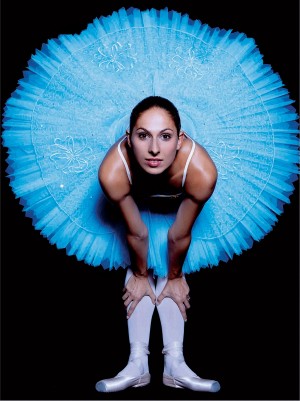Artist of the Week 10/3-10/9: Dina Johnsen Uncovers ‘The Unseen Beauty’ of the National Theatre
GALO: According to your Web site, the Belgrade Theater was founded in 1868 and is one of the oldest cultural establishments in the country. Moreover, its prestige, especially in the area of ballet and opera goes beyond the Republic of Serbia, circulating across many parts of the world due to the frequent travels of the diverse shows. Yet your book is entitled The Unseen Beauty. Wouldn’t you say that there is some irony present there? Or was the book more so a look into the unseen world of the theater – a behind the scenes look of what goes on once the curtain is closed; a comprehensive look into the inner depths of the people that stand behind it?
DJ: There was no irony at all. As I said, the National Theatre (or any cultural institution in Serbia) doesn’t have enough funds to do luxurious photo sessions for its artists or publish beautiful books. That’s why the theatre didn’t have proper pictures of the artists for many, many years. They didn’t have any beautiful albums which could represent the theatre. Many people in Serbia also don’t know that the National Theatre has its own workshop and produces props and costumes for all the performances. It was great to show those people also. They were so proud and so happy to be part of the book as it was the first time when their photos were published.
Thanks to the book the opera singers and ballet artists received more visibility in the glossy media; several of them were offered some advertising contracts by commercial organizations.
So, it was the first glossy photo book in the history of the theatre that’s why it got so much attention. And I am glad that I had this idea.
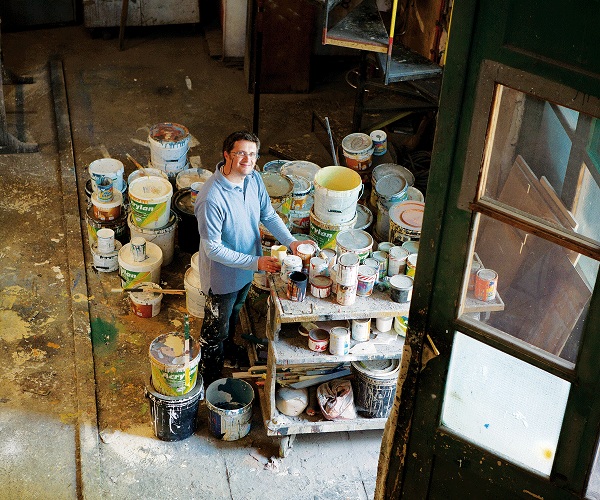
Pictured: Workshop props production. Photo Credit: Dina Johnsen.
GALO: Looking at the photos one cannot help but wonder how much work was put into their creation – the make-up, scene design, costumes, production crew, and time allotted to each photo. You mention on your site that the project took two months to complete and that without the help and cooperation of the production director of the theater, Milorad Jovanovic, none of this would be possible. Can you give us a glimpse into the level of work involved and the people behind the finished product?
DJ: I had my own crew: a stylist, makeup and hair artists. Milorad and his colleagues were helping to make it happen in the theatre. We had to make a very precise schedule of the shootings (as we started on August 23rd, 2011 and the last photo shoot was on October 15th, 2011). So, Milorad Jovanovic was providing availability of the artists, props, spaces in the theatre, electricians, stage managers, etc. Theatre (a big one like that) is a complicated organization, with a lot of bureaucracy involved and one must find a formula to work with its employees effectively and fast. Milorad and his colleague Jasmina Zotovic (the deputy director of the theatre) are very professional people, so we could work non-stop without much problems.
GALO: A lot of the photos were taken in the streets of Belgrade with performers leaning against buildings, walking in parks or streets, or propped on the steps of the theater. For instance, there is an image of a ballet dancer donning a white dress whilst propped up on a bicycle, surrounded by greenery, as well as an image of four ballerinas standing parallel to the pedestrian crossing stripes on a street. Why did you decide to change the scenery of some of the photos instead of taking them all in the studio where the artists spend a good amount of their time? Were you trying to showcase that the performers’ everyday life is made up of their art form – its prevalence being a constant in their lives?
DJ: I wanted originally all the ballet dancers to be photographed in the streets of Belgrade. It was fascinating to place ballerinas in tutus in different spots of the city. I wanted to “bring them closer” to people… Showing them that ballet is not an archaic art — it is lively, fun and beautiful. Due to the deficit of time we couldn’t photograph all the dancers outdoors. So, I had to adjust the concept a bit.
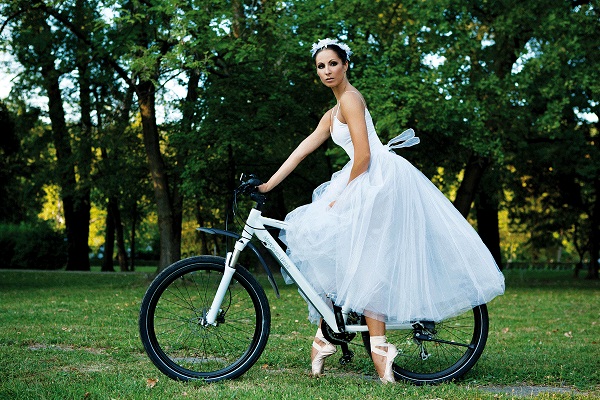
Pictured: Ballet dancer Olga Olcan on a bicycle. Photo Credit: Dina Johnsen.
GALO: The portraits of the drama stars are very emotive. There is a black and white image of a middle-aged man laughing with eyes closed; a woman with wavy, shoulder length hair, her eyes glazed with the formation of new tears, the remnants of those past still running down her face; and a woman with a nervous look in her eyes, biting down on her nails. It is as if they are all acting out a certain role for the camera. Was this the case, and if so, why did they decide to stage an act?
DJ: Yes, the whole idea was to show their talents as actors. It was really wonderful spending time with each of them. During the photo shoot they were talking, screaming, telling their monologues, crying and laughing. Some of them were so incredibly powerful like Predrag Ejdus or extremely beautiful like Nataša Ninković…
GALO: Unlike the rest of the photos, apart from the ones of the Orchestra, the drama images seem to be all photographed in black and white. What was the purpose of this? Where you trying to go for a more dramatic effect; an effort at emphasizing their emotions further?
DJ: Exactly. The colors would distract us otherwise. There was no atmosphere around them, they were all photographed in the studio, and so what I only needed was their emotions.
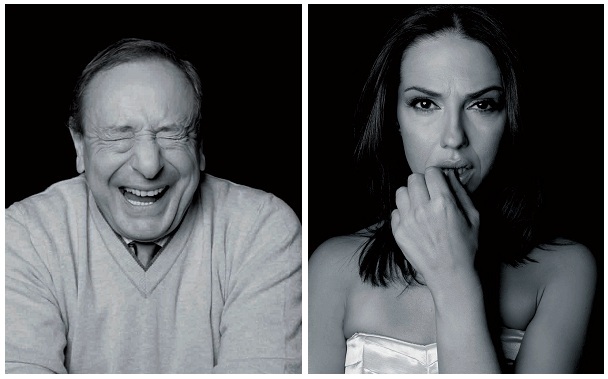
(L-R): Actors Predrag Eidus and Natasa Ninkovic from the National Theatre in Belgrade. Photo Credit: Dina Johnsen.
GALO: As with any collaborative work of art, lessons, memories and experiences are made. What did this project teach you and can you share with us one or two of your favorite moments from the photo shoots?
DJ: It helped me to discover Belgrade. When I came to this city in 2009, I didn’t like it here at all. It looked to me provincial and unsophisticated. I was an ignorant expat. I had no idea back then how great life turned out for me right after I stopped complaining about the service in restaurants or bad telephone manners and started opening up, doing something meaningful, putting effort in understanding the people, learning about their culture. I realized thanks to this project that no matter where you are, you can always find great people, have [an] interesting, fulfilling life and stay happy.
GALO: Lastly, I noticed that the book is no longer being published. Is there a particular reason why its circulation was so scarce (according to Trendhunter.com, only 2,000 copies were made)? I know that you have a few photos available on your Web site of the photos that could be found in the book, but have you considered renewing it or making it into an e-book (or perhaps revealing a photo a day on your site for a limited time), so that people across the world can catch a glimpse into the beauty of the Belgrade Theater as seen through your eyes?
DJ: I had no time to actually work on this side of the business. To make the book available in the stores, I had to find the right publisher and spend time in making the agreement with them, control the quality of the product, etc. I just wanted to continue to photograph and start my new project.
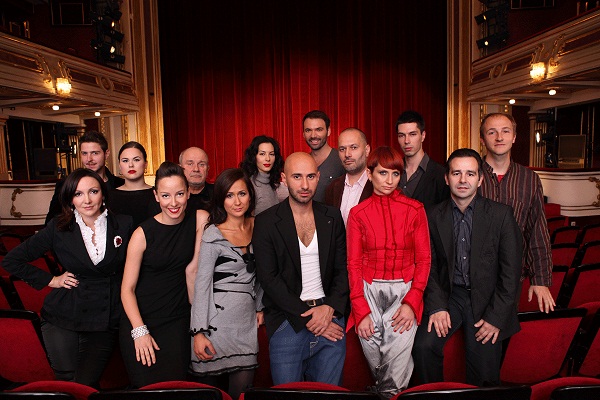
Pictured: “The Unseen Beauty” team. Photo Courtesy of: Dina Johnsen.
When I move to Oslo (in October this year), I will probably have plenty of time working on polishing my Web site and speaking to some potential publishers. My husband got an offer in Oslo, so we are moving again. This means — a new country and a new life again. But before I leave, I will present my second book The Belgrade Book. I am working since March this year on the book which will uncover the beauty of Belgrade as it is not that obvious as Paris, London or New York. I am going to show the city through its best people. I have photographed the most respected celebrities such as Emir Kusturica, Branka Katic, Goran Bregovic, Vlade Velickovic, Vlade Divac, etc. It will be about 40 Serbian best celebrities.


